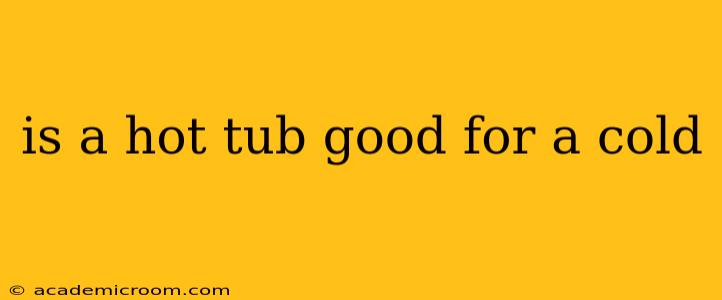Is a Hot Tub Good for a Cold? Soaking in the Benefits (and Risks)
A hot tub soak might sound appealing when you're battling a cold, promising soothing relief from aches and congestion. But is it actually good for a cold? The answer, like many things in health, is nuanced. While a hot tub can offer temporary comfort, it's not a cure and could even worsen your symptoms under certain circumstances. Let's dive into the pros, cons, and considerations.
Can a Hot Tub Help Relieve Cold Symptoms?
Yes, a hot tub can provide temporary relief from some cold symptoms. The heat can:
- Ease muscle aches: Cold often brings on body aches and pains. The warmth of the hot tub can relax muscles and alleviate this discomfort.
- Loosen congestion: The steam from the hot water can help to loosen mucus in your nasal passages and chest, potentially making breathing easier. This is similar to the benefits of a hot shower.
- Promote relaxation: Relaxation is crucial when you're feeling unwell. The warm water and jets can help reduce stress and promote better sleep, both beneficial for recovery.
What are the Risks of Using a Hot Tub with a Cold?
While the potential benefits exist, there are also significant risks to consider:
- Dehydration: Hot tubs can cause significant dehydration, particularly if you're already experiencing fluid loss from a cold. Dehydration can worsen symptoms and prolong your illness.
- Increased body temperature: A high fever is a common cold symptom. The added heat from the hot tub could potentially raise your body temperature further, potentially making you feel worse.
- Spread of germs: Hot tubs are unfortunately breeding grounds for bacteria and viruses. Using a hot tub while you're contagious could spread your illness to others. Proper sanitization is crucial, but even then, the risk remains.
- Worsening symptoms: For some individuals, the heat may worsen existing cold symptoms like coughing or congestion.
Should I Avoid a Hot Tub with a Cold?
This depends on the severity of your cold and your overall health. If you have a mild cold and feel you can handle the potential risks, a short, lukewarm soak might offer some temporary relief. However, it's crucial to:
- Stay well-hydrated: Drink plenty of water before, during, and after your soak.
- Keep the water temperature low: Avoid excessively hot water to minimize the risk of dehydration and overheating.
- Limit your soak time: Keep your soak short – 15-20 minutes maximum – to prevent dehydration and overheating.
- Sanitize thoroughly: Ensure the hot tub is properly cleaned and sanitized to minimize the risk of spreading germs.
- Listen to your body: If you feel any worsening of symptoms, get out of the hot tub immediately.
What are some alternatives to a hot tub for cold relief?
Many safer and equally effective alternatives exist for cold relief. These include:
- Rest: This is vital for your body to fight off the virus.
- Hydration: Drink plenty of fluids, like water, clear broths, and herbal teas.
- Over-the-counter medications: Pain relievers and decongestants can help alleviate symptoms.
- Warm showers or baths: These offer similar benefits to a hot tub without the risks.
- Humidifier: Adding moisture to the air can help loosen congestion.
In conclusion, while a hot tub might provide fleeting comfort for some cold symptoms, the potential risks often outweigh the benefits. Prioritize rest, hydration, and other safer methods of cold relief. If you're unsure, it's always best to consult your doctor before using a hot tub when you're unwell.
